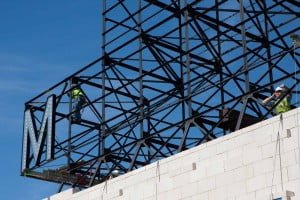Electric Sign Renovation
A LANDMARK ELECTRIC SIGN RENOVATION PROJECT
Signage Renovation at Hotel John Marshall, Richmond, VA
Many times a building bec omes a landmark because of the sign that’s on top of it. In Richmond, Virginia, that’s the case with the Hotel John Marshall. Several years ago, the once grand sixteen story icon had all but faded into the background of Richmond’s historic downtown in dire need of a sign restoration. In 2011, Holiday Signs got the chance to help revive it by restoring its vintage roof marquee.
omes a landmark because of the sign that’s on top of it. In Richmond, Virginia, that’s the case with the Hotel John Marshall. Several years ago, the once grand sixteen story icon had all but faded into the background of Richmond’s historic downtown in dire need of a sign restoration. In 2011, Holiday Signs got the chance to help revive it by restoring its vintage roof marquee.
When the hotel first opened in 1929, it was the largest hotel in Virginia offering all the amenities of luxury hotels of that era. Named after Virginia’s longest serving Supreme Court Chief Justice, its marble and gold lobby, cathedral doorways and spacious stairways lured in many famous guests throughout the years. After the recent $70 million renovation, the refurbished historic hotel now houses multiple floors of residential apartments with retail and office space on the lower levels.
The sign was a historic landmark. It needed work to restore it back to its original vitality. Built years ago and abandoned in 1988, it became a ghostly reminder of its neglected past. It was rusting away. The lighting in the 34 large, 7 foot tall letters was the old incandescent bulb type. There were some 1,400 light bulbs per side which were major energy hogs always in need of maintenance. They regularly burned out and there was a big safety concern involved with changing them.
 When the new owners took on redevelopment in 2009, they needed to make substantial energy improvements to obtain HUD funding. Holiday Signs was chosen as the best firm qualified for the sign restoration. We worked for Choate Interiors, a part of Choate Construction, the General Contractor. Even with the developer’s 3-year relationship with another sign company, we got the
When the new owners took on redevelopment in 2009, they needed to make substantial energy improvements to obtain HUD funding. Holiday Signs was chosen as the best firm qualified for the sign restoration. We worked for Choate Interiors, a part of Choate Construction, the General Contractor. Even with the developer’s 3-year relationship with another sign company, we got the  job because of our technical expertise. From an owner’s point of view, we wanted to make the investment in the sign renovation economic over the lifetime of the sign: both initial cost, and operating costs of energy and maintenance. We also had to make sure the new cost-efficient signage was historically accurate.
job because of our technical expertise. From an owner’s point of view, we wanted to make the investment in the sign renovation economic over the lifetime of the sign: both initial cost, and operating costs of energy and maintenance. We also had to make sure the new cost-efficient signage was historically accurate.
Our creative solution replaced old incandescent bulbs with low-voltage LED lighting that looked historically correct by using modern digital printing technology. We recommended closed face letters with printed covers that would make them look like the old open-faced bulb letters while offering the LED lighting components protection from the elements of the harsh rooftop environment. We demonstrated prototypes and then met with the Chief Architect for the National Park Service (since the hotel overlooks Richmond’s Slave Trail it is under NPS jurisdiction), and representatives from the City of Richmond and the General Contractor to tweak the digitally printed bulb designs and LED lighting placement to where all parties were satisfied with the effect.
modern digital printing technology. We recommended closed face letters with printed covers that would make them look like the old open-faced bulb letters while offering the LED lighting components protection from the elements of the harsh rooftop environment. We demonstrated prototypes and then met with the Chief Architect for the National Park Service (since the hotel overlooks Richmond’s Slave Trail it is under NPS jurisdiction), and representatives from the City of Richmond and the General Contractor to tweak the digitally printed bulb designs and LED lighting placement to where all parties were satisfied with the effect.
By utilizing LED, power consumption for illumination was reduced by 70%. As an added value service, we worked with Dominion Power to get the General Contractor a substantial rebate for the huge energy reduction. Now, after complete electric sign renovation, the renovated sign casts an accurate image of Richmond’s bygone era while utilizing many of the benefits of modern-day sign and lighting technology in its day to day operation.
Residences at the John Marshall Website
Photography Provided by Jim Smith/ Flying Dog Photography,
804.543.3995
For New Sign and Signage Restoration Inquiries, Contact: Mark Hackley, Account Executive, mhackley@holidaysigns.com
If you liked this article, you may also like:
Restoration of an Historic Richmond Theater Marquee
How Digital Messaging Can Help Shopping Centers Lure and Retain Tenants
An Important Wayfinding Term to Learn and Remember
See How One Virginia Mixed-Use Development Makes a Huge First Impression
What is Risk-Free Digital Messaging?
The Value of Sign Prototypes and Getting Things Right on the Ground


















